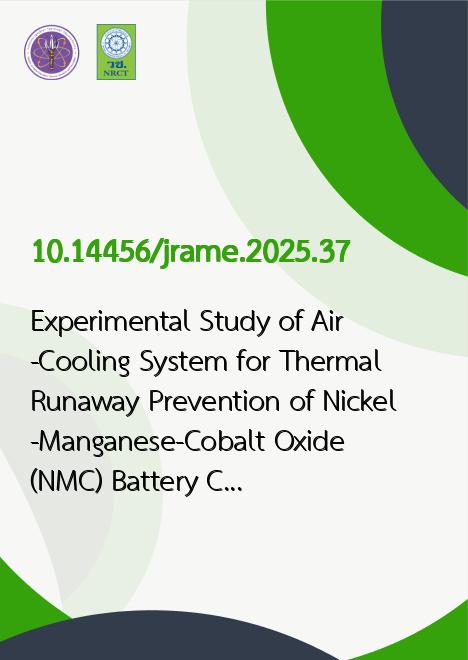
|
Experimental Study of Air-Cooling System for Thermal Runaway Prevention of Nickel-Manganese-Cobalt Oxide (NMC) Battery Cells in Electric Vehicles |
|---|---|
| รหัสดีโอไอ | |
| Creator | 1. K. Hwaiwai 2. M. Masomtob 3. A. Kaewpradap |
| Title | Experimental Study of Air-Cooling System for Thermal Runaway Prevention of Nickel-Manganese-Cobalt Oxide (NMC) Battery Cells in Electric Vehicles |
| Publisher | Thai Society of Mechanical Engineers (TSME) |
| Publication Year | 2568 |
| Journal Title | Journal of Research and Applications in Mechanical Engineering (JRAME) |
| Journal Vol. | 13 |
| Journal No. | 3 |
| Page no. | JRAME-25-13-037 (p.1-12) |
| Keyword | Battery thermal runaway, Air-cooling system, Internal Short Circuit, Cooling-time, Electric vehicle |
| URL Website | https://ph01.tci-thaijo.org/index.php/jrame/index |
| Website title | Journal of Research and Applications in Mechanical Engineering (JRAME) |
| ISSN | 2229-2152 |
| Abstract | Battery thermal runaway (BTR) is a critical safety concern in electric vehicles (EVs), where heat generated within the battery can spread to adjacent cells, potentially causing explosions. This study investigates 18650-type NMC cylindrical cells to develop strategies for preventing battery fires linked to internal short circuits (ISCs) and self-heating, which can lead to BTR. We analyzed the impacts of battery surface temperature, blower speed, and cooling duration on preventing BTR. An air-cooling system was utilized to maintain surface temperatures at 90 ℃, 95 ℃ and 100 ℃, with air velocities at 1.92 m/s and cooling times of 5, 10, and 15 minutes. While BTR occurred with insufficient cooling time, cells cooled for at least 10 minutes at 90 ℃ and 95 ℃ showed no BTR signs. Importantly, at 100 ℃, no ISCs were observed after 15 minutes of cooling, demonstrating the effectiveness of proper cooling in preventing BTR. |
